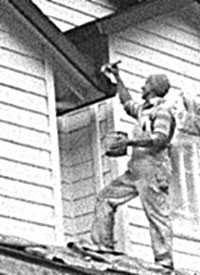Repainting aluminum siding
Don't live with a fading, deteriorating exterior

[
{
"name": "Air - MedRect Combo - Inline Content 1",
"component": "11490391",
"insertPoint": "3",
"requiredCountToDisplay": "1",
"parentWrapperClass": "fdn-ads-inline-content-block"
},{
"name": "Air - MedRect Combo - Inline Content 2",
"component": "11490392",
"insertPoint": "7",
"requiredCountToDisplay": "5",
"parentWrapperClass": "fdn-ads-inline-content-block"
},{
"name": "Air - MedRect Combo - Inline Content 3",
"component": "11490393",
"insertPoint": "12",
"requiredCountToDisplay": "9",
"parentWrapperClass": "fdn-ads-inline-content-block"
}
]
Dear Gene: My house has aluminum siding. The finish
is faded and deteriorated. Can I successfully repaint the siding? —
M.K.
Aluminum siding can be successfully repainted, but there is some controversy about how to do it. I have seen instructions that call for using an acrylic paint and no primer except on bare spots, but I don’t think that that is the best approach. One of the big problems with painting aluminum siding is that the old finish often “chalks” or oxidizes badly, leaving a fine powder on the surface that makes it difficult for new paint to adhere. You can check your siding for chalk by wiping the palm of your hand over the surface — if it picks up chalky smudges, you’ll need careful preparation. Start by washing the surface to remove as much chalk as possible. Pressure washing is the best way to do this, but if your house is small you can hand-clean it by scrubbing with a solution of TSP (trisodium phosphate, sold at paint stores) and rinsing. Let the siding dry thoroughly, then apply an oil-based (alkyd) primer. When the primer is dry, you can finish-paint with high-quality acrylic house paint. Aluminum siding has largely given way to vinyl in newer homes and when siding is being replaced, but with a good paint job your aluminum can look like new again.
Dear Gene: The linoleum on my kitchen floor is about 15 years old and has developed a lot of small black spots and cracks in front of the refrigerator and sink. Can you tell me what caused these problems before I replace the flooring? — I.P.
I think your flooring is simply wearing out. The floor areas you mentioned are high-traffic areas, with lots of scraping and impact from shoes. When you have new flooring installed, you can cut down on the wear in those areas by using throw rugs.
Dear Gene: When we stained our deck, some stain got on the vinyl siding of our house. Can you tell us how to remove the stains? — T.P.
Deck-stain removers are available at some home centers. I tried one of these on vinyl siding and saw no damage from the remover, but you should test any product on a small, inconspicuous place. A couple of examples of deck-stain removers are Flood’s StainStrip (www.floodco.com), and DeckStrip by Wolman (www.wolman.com).
Dear Gene: My 50-year-old house has settled unevenly over the years, and I want to restore it to level before I do some remodeling. I’ve been told that the house can be detached from the foundation and lifted, after which a level coat of concrete can be spread on top of the foundation. Does this sound like a good approach? — John
Houses are sometimes jacked up and leveled in this manner, but this is a problem that would require personal inspection and expert advice. If you haven’t had a structural engineer examine your house and foundation, you should. The engineer can then advise you on the method or methods that are best suited to leveling your house.
Dear Gene: The stairs in my house squeak badly. I have good access to them from underneath but not from the top (carpeted) or sides (drywall in the way). How can I stop the squeaking? — D.W.
Get under the stairs and have someone walk on them to identify those that squeak. Watch for slight movement in the treads when weight is put on them, and check for small gaps at the sides or at the point where treads meet risers (the vertical parts of the steps) and the stringers (the notched sides that support the treads and risers). Mark the points where you think movement in treads is causing squeaks. Cut cleats of 2-by-4 wood to support the squeaking treads. Spread wood glue on the back and top of a cleat and screw it to the stringer or riser, forcing it snugly against the tread. Be careful not to use screws so long that they penetrate risers or stringers. Test this method on one or two of the worst squeakers to see if it stops the noise. If appearance is important, use small wood wedges or shims instead of 2-by-4 cleats to close gaps. Coat the shims with glue and tap them into place with a mallet or hammer to close gaps. Shims are sold in small bundles at some home centers.
Aluminum siding can be successfully repainted, but there is some controversy about how to do it. I have seen instructions that call for using an acrylic paint and no primer except on bare spots, but I don’t think that that is the best approach. One of the big problems with painting aluminum siding is that the old finish often “chalks” or oxidizes badly, leaving a fine powder on the surface that makes it difficult for new paint to adhere. You can check your siding for chalk by wiping the palm of your hand over the surface — if it picks up chalky smudges, you’ll need careful preparation. Start by washing the surface to remove as much chalk as possible. Pressure washing is the best way to do this, but if your house is small you can hand-clean it by scrubbing with a solution of TSP (trisodium phosphate, sold at paint stores) and rinsing. Let the siding dry thoroughly, then apply an oil-based (alkyd) primer. When the primer is dry, you can finish-paint with high-quality acrylic house paint. Aluminum siding has largely given way to vinyl in newer homes and when siding is being replaced, but with a good paint job your aluminum can look like new again.
Dear Gene: The linoleum on my kitchen floor is about 15 years old and has developed a lot of small black spots and cracks in front of the refrigerator and sink. Can you tell me what caused these problems before I replace the flooring? — I.P.
I think your flooring is simply wearing out. The floor areas you mentioned are high-traffic areas, with lots of scraping and impact from shoes. When you have new flooring installed, you can cut down on the wear in those areas by using throw rugs.
Dear Gene: When we stained our deck, some stain got on the vinyl siding of our house. Can you tell us how to remove the stains? — T.P.
Deck-stain removers are available at some home centers. I tried one of these on vinyl siding and saw no damage from the remover, but you should test any product on a small, inconspicuous place. A couple of examples of deck-stain removers are Flood’s StainStrip (www.floodco.com), and DeckStrip by Wolman (www.wolman.com).
Dear Gene: My 50-year-old house has settled unevenly over the years, and I want to restore it to level before I do some remodeling. I’ve been told that the house can be detached from the foundation and lifted, after which a level coat of concrete can be spread on top of the foundation. Does this sound like a good approach? — John
Houses are sometimes jacked up and leveled in this manner, but this is a problem that would require personal inspection and expert advice. If you haven’t had a structural engineer examine your house and foundation, you should. The engineer can then advise you on the method or methods that are best suited to leveling your house.
Dear Gene: The stairs in my house squeak badly. I have good access to them from underneath but not from the top (carpeted) or sides (drywall in the way). How can I stop the squeaking? — D.W.
Get under the stairs and have someone walk on them to identify those that squeak. Watch for slight movement in the treads when weight is put on them, and check for small gaps at the sides or at the point where treads meet risers (the vertical parts of the steps) and the stringers (the notched sides that support the treads and risers). Mark the points where you think movement in treads is causing squeaks. Cut cleats of 2-by-4 wood to support the squeaking treads. Spread wood glue on the back and top of a cleat and screw it to the stringer or riser, forcing it snugly against the tread. Be careful not to use screws so long that they penetrate risers or stringers. Test this method on one or two of the worst squeakers to see if it stops the noise. If appearance is important, use small wood wedges or shims instead of 2-by-4 cleats to close gaps. Coat the shims with glue and tap them into place with a mallet or hammer to close gaps. Shims are sold in small bundles at some home centers.
Illinois Times has provided readers with independent journalism for almost 50 years, from news and politics to arts and culture.
Your support will help cover the costs of editorial content published each week. Without local news organizations, we would be less informed about the issues that affect our community..
Got something to say?
Send a letter to the editor and we'll publish your feedback in print!














